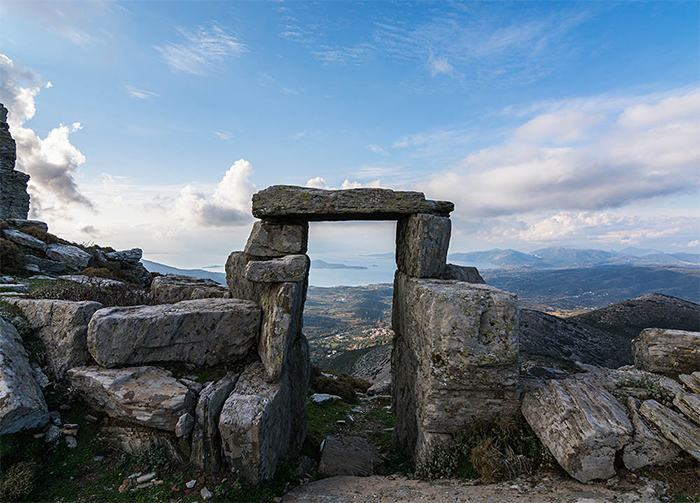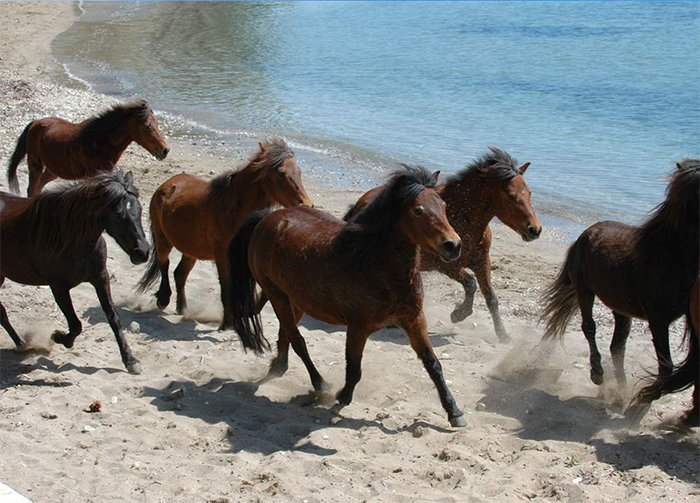Walking the Greek Islands Evia, Skyros and Kea

This is a fantastic way to holiday, but if you are looking for something a little more active, the Greek islands have that too.
European adventure tourism has been booming in popularity in the past few years. Biking along the Amalfi Coast, sailing down the Danube and walking the ancient volcanos of Pompeii are just a few of the adventures available. And Greece, the jewel of the Aegean Sea, is one of the best of the adventure destinations. Because the majority of Greece is mountainous, it is a natural hiker’s paradise throughout. But hiking on the small islands is the real stand out.
Here you’ll find a variety of different paths that are witness to the islands’ long history, rich culture and fantastic biodiversity. The kalderimia, which are cobbled or flagstone paths, have linked the various settlements and villages since Byzantine times. The monopatia, on the other hand, are rough and often unmarked shepherds’ trails that link remote settlements together.
And while there are many amazing islands to explore on foot, Evia, Skyros and Kea are three of our absolute favourites.

Walking Evia: Steni Forest and the Dragon Houses
Steni Forest in central Evia is one of these forest paradises, and boasts a well-marked network of trails, which run among stands of fir and chestnut trees. Due to an unusually large number of springs, the area is teeming with rivers and streams and has an outstanding variety of flora species. The forest is also known for its geomorphologic features, which include rocks dating back to the Jurassic and Triassic Periods.
Evia has a robust history and more ancient sites than almost any of the other Greek islands. Some of the most interesting are the Dragon Houses. Called ‘Drakospita’, the Dragon Houses are ancient structures constructed of huge stone blocks. Their purpose is completely unknown and they continue to puzzle the archaeologists who study them.
The Dragon Houses are found scattered among the slopes of Mount Ochi, with one remarkable version near the summit. The trails in this area are well sign posted and even without the Dragon Houses, a walk here is certainly worth your time. Mount Ochi is astoundingly beautiful and from its summit there are staggering views of the Evian Gulf.
Evia boasts a great number of additional walks and hikes that are worth looking into. Consider visiting Lake Dystos, a haven for migratory birds, or the Oxylithos Volcano, a jagged hill with the picturesque church of Evangelistrias on its slopes.

Walking Skyros: The Skyrian Horse and the Trojan War
Skyros is unique in that it is essentially two completely different islands joined together. Its northern half is covered in verdant greenery, including farmlands and pine forests. The southern half, on the other hand, is ruggedly barren and dry, but with wetlands on its plateaus.
The south also boasts the island’s tallest mountain, Kochylas. Much of the Kochylas area has been designated as part of the European Union’s Natura 2000 network of protected nature areas due to its rich biodiversity of falcons, sea birds, lizards and endemic plants.
There are great hiking trails on Skyros that showcase its changing scenery and the traces of history that remain scattered on the island. One starts from the Ari plateau amidst lovely oaks, maples and phillyrea. This area is also home to the wild Skyrian Horse, a rare pony-sized breed found nowhere else in the world. Some experts believe these horses are descended from those used by Alexander the Great.
You can also begin at Renes Bay and cross the plateau known as Aragadas. Here are more herds of the beautiful Skyrian horses, and from April to October you can see the beautiful Eleonora’s Falcon nesting on the cliffs surrounding the plateau. The scenery is magnificent with steep cliffs plunging into blue waters.
There are also several walks that begin at Achilli Bay where, according to Greek mythology, Achilles departed for the Trojan War. From here you can hike up to one of the most beloved churches on Skyros, Saint Artemios. Built in a cave on the northeast side of Kochylos, it has magnificent views of the Aegean Sea and the plains of Kallikri.

Walking Kea: The Four Ancient Cities of Ioulida, Karthaia, Koressia and Poiessa
While it has exceptional beaches, lovely towns, cultural events and some of the best restaurants in Greece, Kea is most interesting because it has one of the best systems of walking trails of any of the Greek islands.
In fact, the mountainous interior of Kea has over 81 kilometres of walking trails, many of which are stone paved, from which to view its amazingly varied landscape. While during the summer months it seems a dry, rocky island, in the spring it is abundant with wildflowers and gorgeous green valleys, springs and the only oak forest in all of the Cycladic islands.
Kea is one of the few islands with many of its ancient roads still intact and you can follow them from one end of the island to the other, treading where ancient peoples have tread. During the Archaic period the island was divided between four city-states, Ioulida, Karthaia, Koressia and Poiessa, and it is possible to walk between each of the ancient city-states by following these ancient paths.
Make time to follow the ‘Leon’ Route, which takes you past the famous Lion of Kea as well as the ‘Elixos’ route whose cobbled path lies over the remains of the ancient Ioulis-Korissia road. This road will take you past the valley of the famous Kean watermills, where historically each of the villages would bring their grain to be ground into flour.
There is no better way to explore Evia, Skyros and Kea, or any of the islands in fact, than on foot – walking where ancient people have walked, visiting the amazing historical sights and taking in the astounding views.
If you’d like more travel information, please don’t hesitate to contact our team on 1800 242 353.
